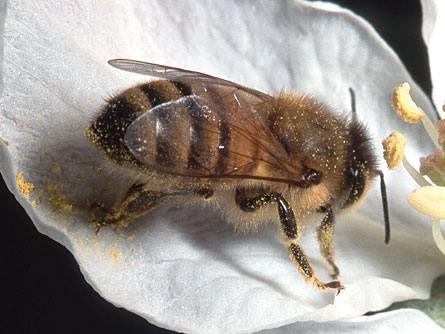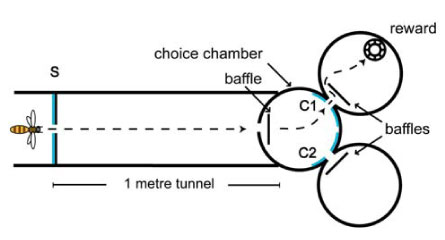Honeybees know a thing or two, or three. Even when tricky scientists make those things look different.


Teach a honeybee to recognize two blue dots and she can then find two star or lemon icons or even a mixed picture of a lemon and a flowerlike purple blob, says a new study.
Bees can use their visual sense of number to generalize from one kind of image to another, says Shaowu Zhang at the Australian National University in Canberra.
In picking out the right number of elements, bees aren’t taking any of the numerical shortcuts the researchers tested. For example, the bees aren’t just looking at total area, position or outline shape of the grouping, Zhang and his colleagues report online January 27 in PLoS ONE.
“This is the first report of visual generalization of number in honeybees,” Zhang says. “I have been studying honeybees since 1980, and I am often surprised by our experimental results. The bee is smart.”
What animals can do with numbers has intrigued biologists studying the evolutionary roots of cognition. Experiments based on selecting same-number patterns have shown some kind of numerical ability in birds, primates, dolphins, raccoons and even salamanders.
Such experiments have tested many more vertebrates than invertebrates though. Honeybees seemed like good candidates for study, the researchers say, because other recent research has found evidence of some fancy bee cognition. Bees can learn sameness and difference, for example. Coauthor Jürgen Tautz of the University of Würzburg in Germany predicts “astonishment of experts and laymen alike” at the sophistication of the tiny honeybee.
The new test represents a useful extension of earlier work, says bee scientist Lars Chittka of Queen Mary, University of London. His research has shown that bees can count off landmarks to reach a destination and a reward.
To see whether bees can take what they learn about number from one kind of icon and apply it to different ones, Zhang and Tautz’s labs trained bees to fly through a little tunnel with a choice of exits.
In the tests, a bee zoomed along a meter of tunnel and then through a hole marked with a reference pattern, such as two blue dots. Once through the hole, the bee had to choose between two exits, each marked with a pattern. If the bee chose the exit marked with the same number of elements as the reference pattern, she ended up in a little chamber with a reward.
Researchers trained about 20 bees to distinguish between two or three blue dots. Bees plateaued at about 70 percent correct choices. The researchers then presented the bees with increasingly tougher challenges. One reference pattern with three dots led to a choice between different patterns, either two fat dots or three skimpy ones, having the same total areas. Or bees had to choose the right number of elements even when researchers used confusing icons.
Bees could distinguish between two and three, and could also tell between three and four when matching to a three-element pattern. But presenting a four-element pattern was going a little far. This time bees didn’t distinguish between four and three.
Before any humans get too smug, the researchers point out that memory studies have suggested that the number of things a person can consciously remember at any one time is typically around — four.
Zhang and Tautz aren’t saying that the bees count to two or three in the human sense. Even if scientists expected bees and humans to have such similar cognitive processes, demonstrating bee counting would take some remarkable cross-species mind reading.
Chittka says the strategy of extracting a visual sense of “twoness” or “threeness” from an image and applying it later might actually be a strategy to economize on memory. “It might require less ‘storage space’ to just remember a feature by which you can identify several relevant targets,” he says.
“So while many researchers still adhere to the view that smaller brains automatically mean ‘less intelligence,’ the opposite might sometimes be the case,” Chittka says. Honeybees might be getting by with less memory capacity because they use clever strategies like categorization.






